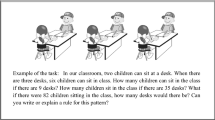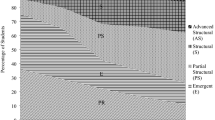Abstract
Expressing generality, recognising and analysing patterns and articulating structure is a complex task and one that is invariably problematic for students. Nonetheless, very few systems exist that support learners explicitly in the process of mathematical generalisation. We have addressed this by developing a novel environment that supports users in their reasoning and problem-solving of generalisation tasks. We have followed a stakeholder-centred design process, integrating feedback and reflections from twenty-four children, five teachers and a variety of other stakeholders. This paper focuses on several inter-related design issues that have been informed by this iterative process and demonstrates how the system can be used for a typical generalisation task to foster an appreciation of generality and indeed algebra.
The authors would like to acknowledge the rest of the members of the MiGen team and financial support from the TLRP (e-Learning Phase-II, RES-139-25-0381).
Preview
Unable to display preview. Download preview PDF.
Similar content being viewed by others
References
Mason, J., Graham, A., Johnston-Wilder, S.: Developing Thinking in Algebra. Paul Chapman Publishing, Boca Raton (2005)
Noss, R., Healy, L., Hoyles, C.: The construction of mathematical meanings: Connecting the visual with the symbolic. Educational Studies in Mathematics 33(2), 203–233 (1997)
Tall, D., Thomas, M.: Encouraging versatile thinking in algebra using the computer. Educational Studies in Mathematics 22(2), 125–147 (1991)
Roschelle, J., Kaput, J.: SimCalc MathWorlds: Composable components for calculus learning. Communications of the ACM 39, 97–99 (1996)
Kieran, C., Yerushalmy, M.: Research on the role of technological environments in algebra learning and teaching. In: Stacey, K., Shick, H.H., Kendal, M. (eds.) The Future of the Teaching and Learning of Algebra. The 12th ICMI Study. New ICMI Study Series, vol. 8, pp. 99–152. Kluwer Academic Publishers, Dordrecht (2004)
Hoyles, C., Healy, L.: Visual and symbolic reasoning in mathematics: Making connections with computers. Mathematical Thinking and Learning 1(1), 59–84 (1999)
Underwood, J., Cavendish, S., Dowling, S., Fogelman, K., Lawson, T.: Are integrated learning systems effective learning support tools? Computers and Education 26, 33–40 (1996)
Pelgrum, W.: Obstacles to the integration of ICT in education: results from a world-wide educational assessment. Computers and Education 37, 163–178 (2001)
Küchemann, D., Hoyles, C.: Investigating factors that influence students’ mathematical reasoning. PME XXV 3, 257–264 (2001)
Healy, L., Hoyles, C.: A study of proof conceptions in algebra. Journal for Research in Mathematics Education 31(4), 396–428 (2000)
Moss, J., Beatty, R.: Knowledge building in mathematics: Supporting collaborative learning in pattern problems. International Journal of Computer-Supported Collaborative Learning 1, 441–465 (2006)
Noss, R., Hoyles, C.: Windows on mathematical meanings: Learning cultures and computers. Kluwer, Dordrecht (1996)
Sutherland, R., Mason, J.: Key aspects of teaching algebra in schools. QCA, London (2005)
Mason, J.: Generalisation and algebra: Exploiting children’s powers. In: Haggarty, L. (ed.) Aspects of Teaching Secondary Mathematics: Perspectives on Practice, pp. 105–120. Routledge Falmer and the Open University (2002)
Duke, R., Graham, A.: Inside the letter. Mathematics Teaching Incorporating Micromath 200, 42–45 (2007)
Warren, E., Cooper, T.: Generalising the pattern rule for visual growth patterns: Actions that support 8 year olds’ thinking. Educational Studies in Mathematics 67, 171–185 (2008)
Papert, S.: Mindstorms: Children, Computers, and Powerful Ideas. Perseus Books, U.S (1993)
Gutiérrez, S., Mavrikis, M., Pearce, D.: A learning environment for promoting structured algebraic thinking in children. In: Int. Conf. in Advanced Learning Technologies (ICALT 2008). IEEE Computer Society Press, Los Alamitos (2008)
Schneiderman, I.E.: Direct manipulation: A step beyond programming languages. IEEE Computer 16, 57–69 (1983)
Hutchins, E.L., Hollan, J.D., Norman, D.A.: Direct manipulation interfaces. Human-Computer Interaction 1, 311–338 (1985)
Orey, M., Nelson, W.: Development principles for intelligent tutoring systems: Integrating cognitive theory into the development of computer-based instruction. Educational Technology Research and Development 41(1), 59–72 (1993)
VanLehn, K.: Student modeling. In: Polson, M., Richardson, J. (eds.) Foundations of Intelligent Tutoring Systems, pp. 55–78. Erlbaum, Hillsdale (1988)
Healy, L., Heltz, R., Hoyles, C., Noss, R.: Messing up. Micromath 10, 14–17 (1994)
Author information
Authors and Affiliations
Editor information
Rights and permissions
Copyright information
© 2008 Springer-Verlag Berlin Heidelberg
About this paper
Cite this paper
Pearce, D., Mavrikis, M., Geraniou, E., Gutiérrez, S. (2008). Issues in the Design of an Environment to Support the Learning of Mathematical Generalisation. In: Dillenbourg, P., Specht, M. (eds) Times of Convergence. Technologies Across Learning Contexts. EC-TEL 2008. Lecture Notes in Computer Science, vol 5192. Springer, Berlin, Heidelberg. https://doi.org/10.1007/978-3-540-87605-2_37
Download citation
DOI: https://doi.org/10.1007/978-3-540-87605-2_37
Publisher Name: Springer, Berlin, Heidelberg
Print ISBN: 978-3-540-87604-5
Online ISBN: 978-3-540-87605-2
eBook Packages: Computer ScienceComputer Science (R0)




